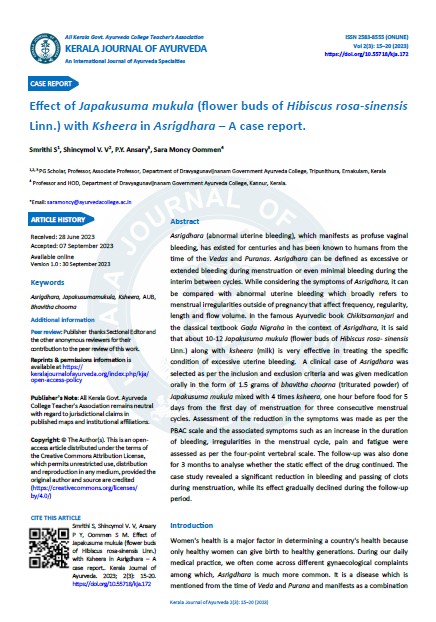Effect of Japakusuma mukula (flower buds of Hibiscus rosa-sinensis Linn.) with Ksheera in Asrigdhara – A case report.
DOI:
https://doi.org/10.55718/kja.172Keywords:
Asrigdhara, Japakusumamukul, Ksheera, AUB, SnehapanaAbstract
Asrigdhara (abnormal uterine bleeding), which manifests as profuse vaginal bleeding, has existed for centuries and has been known to humans from the time of the Vedas and Puranas. Asrigdhara can be defined as excessive or extended bleeding during menstruation or even minimal bleeding during the interim between cycles. While considering the symptoms of Asrigdhara, it can be compared with the abnormal uterine bleeding which broadly refers to menstrual irregularities outside of pregnancy that affect frequency, regularity, length and flow volume. In the famous Ayurvedic book Chikitsamanjeri and in the classical textbook Gada Nigraha in the context of Asrigdhara it is said that, about 10-12 Japakusuma mukula (flower buds of Hibiscus rosa- sinensis Linn.) along with ksheera (milk) is very effective in treating the specific condition of excessive uterine bleeding. A clinical case of Asrigdhara was selected as per the inclusion and exclusion criteria and was given medication orally in the form of 1.5 grams of bhavitha choorna (triturated powder) of Japakusuma mukula mixed with 4 times ksheera, one hour before food for 5 days from the first day of menstruation for three consecutive menstrual cycles. Assessment of the reduction in the symptoms were made as per PBAC scale and the associated symptoms such as increase in the duration of bleeding, irregularities in menstrual cycle, pain and fatigue were assessed as per the four-point vertebral scale. The follow up was also done for 3 months to analyse whether static effect of the drug continues. The case study revealed significant reduction in bleeding and passing of clots during menstruation, while its effect gradually declined during the follow-up period.
References
Agnivesa. Charaka Samhitha Vol. 1. Trans Ram Karan Sharma and Vaidya Bhagavan Das. Seventh ed. Varanasi-1: Choukahamba Sanskrit Series office; 2001 Sutrasthanam chapter 28. sloka 11 p.576.
Agnivesa. Charaka Samhitha Vol. 4. Trans Ram Karan Sharma and Vaidya Bhagavan Das. reprinted. Varanasi-1: Choukahamba Sanskrit Series office; 2007 chikitsasthana 28 sloka 230 p.82.
Susrutha.Illustrated Susrutha Samhitha vol1.Trans Prof.K.R.Srikantamurthy Third ed. Varanasi: Choukambha Orientalia 2007 nidanastana chapter 1 sloka 37 p.466.
Susrutha.Illustrated Susrutha Samhitha vol1.Trans Prof.K.R.Srikantamurthy Third ed. Varanasi: Choukambha Orientalia 2007 sutrasthana chapter24 sloka9.p.179.
D.C.Dutta edited by Hiralal Konar ;Textbook of Gynecology.7th edition.New Delhi; Jaypee Brothers Medical Publishers(P)Ltd ;2016.chapter 15. Abnormal uterine bleeding. P.152 .
Davis E, Sparzak PB. Abnormal Uterine Bleeding. [Updated 2022 Sep 9]. In: StatPearls [Internet]. Treasure Island (FL): StatPearls Publishing; 2022 Jan-. Available from: https://www.ncbi.nlm.nih.gov/books/NBK532913/.
Howkin’s and Bourne Shaw’s Textbook of Gynaecology. Edited by VG Padubidri, Shirish N Daftary 16th ed. New Delhi: RELX India Pvt Ltd; 2016. Chapter 24.Menorrhagia . p.339. .
Chikitsamanjari. Sreeman Nambootiri. 7th ed. Kodungallor: Vidyarambham publications; 2005. Asrigdhara chikitsa.p.103.
Sodhala. Gadanigraha. Part 3. Edited by Ganga sahaya pandeya. Varanasi: Chaukhambha Sanskrit sansthan; Reprint. 2011. Pradaradhikara Prathama. sloka 43.p. 453.
Saligrama. Saligrama Nighantu Bhooshanam. Bombay: Khemaraj Srikrishnadas Prakashan; 2006. Pushpa varga.p. 391.
Bapalal G Vaidya. Nighantu Adarsa. Vol 1. Varanasi: Chaukambha Bharati Academy; 2007.p.163-171.
Orient Logman. Indian Medicinal Plants. A Compendium of 500 species. Arya Vaidya Sala, Kottakkal; Volume 3. p.149.
Manilal K.S, editor. Van Rheede’s Hortus Malabaricus. Thiruvanathapuram: vol 6 Department of publications University of Kerala; 2003 June. p.145-147.
Shri Govind Das. Bhaisajya Ratnavali. Edited and enlarged by Bhisagratna Shri Brahmashankar Misra, Shri Kaviraj Ambikadatata Shastri Ayurvedacharya ,editor. Shri Rajeswardatta Shastri.19th edition.Vranasi; Choukhambha prakasan; 2008 chap 4 . Paribhasha Prakarana. sloka117; p.61.
Julia Magnay, Patrick Michael Shaughn’O Brien, Christoph Gerlinger,Christian Seitz. “A systematic review of methods to measure menstrual blood loss.” August 2018 BMC Women’s Health 18(1) DOI:10.1186/s12905-018-0627-8.
Sivarajan.V.V , Indira Balachandran. Ayurvedic Drugs and their Plant Sources. New Delhi: Oxford & IBH Publishing co. Pvt. Ltd; Reprint2006. p.192.
Agarwal.V.S. Drug plants of India. Vol 1. Ludhiana: Kalyani Publishers; First ed.1997. p.418.
Bapalal G Vaidya. Nighantu Adarsa. Vol 1. Varanasi: Chaukambha Bharati Academy; 2007.p.163-171.
Priya Vrat Sharma. Pushpayurveda-Flowers in health and disease. Varanasi: Chaukhambha visvabharati; ed.2006. p.23.
Kaiyyadeva. Kaiyyadeva Nighantu. Translated by P V Sharma and G P Sharma. Varanasi: Chaukambha Orientalia; 2013.Oshadhi varga. p.627.
Mahendra Bhogika. Dhanwanthari Nighantu. Translated by Amritpal Singh. First ed. Varanasi: Chaukhambha publishers; 2008.p. 220-222.
Haritha. Haritha Samhitha Vol 1. Edited by Gyanendra Pandey. First ed. Varanasi: Chaukhambha Sansrit Series office; 2014. Sutrasthana Chapter 8 Dugdha varga . Sloka 18. P.66.
Kaiyyadeva. Kaiyyadeva Nighantu. Translated by P.V.Sharma .G.P.Sharma. Varanasi: Chaukhambha Orientalia; 2013. Sloka 123-129 P. 340-345.
Morotti A, Charidimou A, Phuah C, et al. Association Between Serum Calcium Level and Extent of Bleeding in Patients With Intracerebral Hemorrhage. JAMA Neurol. 2016;73(11):1285–1290. doi:10.1001/jamaneurol.2016.2252.
Alanwar A, Abbas AM, Hussain SH, Elhawwary G, Mansour DY, Faisal MM, Elshabrawy A, Eltaieb E. Oral micronised flavonoids versus tranexamic acid for treatment of heavy menstrual bleeding secondary to copper IUD use: a randomised double-blind clinical trial. Eur J Contracept Reprod Health Care. 2018 Oct;23(5):365-370. doi: 10.1080/13625187.2018.1515349.
Janssen K, Mensink RP, Cox FJ, Harryvan JL, Hovenier R, Hollman PC, Katan MB. Effects of the flavonoids quercetin and apigenin on hemostasis in healthy volunteers: results from an in vitro and a dietary supplement study. Am J Clin Nutr. 1998 Feb;67(2):255-62. doi: 10.1093/ajcn/67.2.255. PMID: 9459373.
Mukherjee, G.G. & Gajaraj, A.J. & Mathias, J & Marya, D. (2005). Treatment of abnormal uterine bleeding with micronized flavonoids. International journal of gynaecology and obstetrics: the official organ of the International Federation of Gynaecology and Obstetrics. 89. 156-7. 10.1016/j.ijgo.2004.11.032.
Deeny J. Vitamin C and the Menstrual Function. Ulster Med J. 1940 Oct;9(2):117-24. PMID: 20476248; PMCID: PMC2479725.





